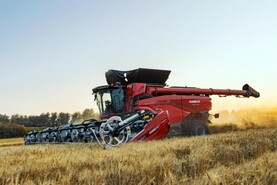It was interesting to see Shay Phelan of Teagasc launch a specimen machine sharing agreement at the recent crops forum in Naas.
Increasing input costs are a feature across all tillage crops currently and fixed costs, which include machinery, are not immune to this trend.
Many tillage farms are relatively small in size and this makes it difficult to justify the ever-increasing cost of machinery.
With the average tillage farm area being around 60 hectares, it is difficult to impossible to justify many of the expensive machines used on modern tillage farms.
This was a significant driver behind this initiative, which merely attempts to guide or formalise machine sharing arrangements.
Modelled on the CUMA
Speaking at the launch, Shay referenced the CUMA system in France, which roughly translates to the “co-operative for the supply of mechanisation to agriculture”.
That system enables a number of farmers to come together to help spread the cost of specific individual bits of machinery.
This has the potential to decrease the overall cost on each of the sharing farms, while possibly decreasing the unit cost of that machine for an individual grower.
Such arrangements can also have the additional benefit of providing additional labour at critical times of year, as those involved frequently come together to help facilitate access to the shared machine(s).
Participants’ agreement
Shay emphasised that any such machine sharing agreement is arranged and agreed between the individuals involved. Third parties may help to formulate an agreement, but they are not part of it.
For this reason, every arrangement could be quite different and an individual grower could have different arrangements with different individuals.
That said, it is important that any and all such agreements be carefully considered and planned. Such plans must consider the practical implications relating to the type of machine and the agreement being entered into.
The document recommends that all such agreements appoint a dispute resolution person to assist in the event of a problem arising.
It should also spell out the details regarding the insurance and taxation of the machine(s), plus matters relating to any loans or trade-ins that may pertain to the transaction.
Who is involved
An agreement must document the names of all parties to the arrangement and identify the specific machines which pertain to each agreement.
It should also identify in advance what procedures will be used when an agreement is set to expire and how any financial considerations should be dealt with. The agreement should set down a depreciation schedule for the machine(s) involved.
Getting access
The agreement must also specify the arrangements for the booking procedure for a machine and how repayments and repairs are to be allocated between the parties involved.
It should also specify where the machine in question would normally be stored.
Shay commented that one of the benefits of any such agreements was the fact that individuals may work more closely together for the common good.
This has frequently resulted in a number of people in fields at critical workload times, making it less lonesome, while enabling more total work to be done.
A useful exercise
During discussion, it was generally agreed that any such conversation between two or more individuals, whether it results in a machinery sharing agreement or not, is potentially useful in terms of helping to better understand the intricacies of their business.
Contractor option
During discussion it was also acknowledged that access to machinery might better be provided by contractors for some growers.
This saves on the direct cost associated with any agreement while potentially providing the contractor with labour, which is an increasingly scarce entity on many farms.






 This is a subscriber-only article
This is a subscriber-only article











SHARING OPTIONS: